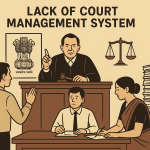By : Vedika, Vanshika prajapat
1. INTRODUCTION
The judiciary is considered the backbone of democratic society, ensuring justice , equality and protection of rights . In India however, judicial system faces a major challenge due to the lack of court management system . Court across the country are burdened with an overwhelming number of pending cases, delays in hearing, and inadequate use of modern technology. proper court management – which includes efficient case handling , use of digital tools, is essential for proper functioning of courts and to restore the public trust and strengthen the justice delivery system in India
2 . Present scenario
India faces a crisis of judicial pendency with over 5 crore pending cases across Supreme, High and lower courts , inefficient case management system.
Current pendency statistics (as of August 2025)
. Total cases: over 5.38 crore cases are pending across all parts.
. Supreme court: Approximately 87,569 pending cases.
. Lower court: About 4.74 crore pending cases.
. Long – pending cases: More than 1.80 lakh cases are over 30 years old in district and high courts.
3 . Problem due to the lack of court management
• Case backlog and pendency:
The sheer volume of cases is overwhelming, with crores pending in district courts and lakhs in high court, leading to extremely long waiting times for resolution.
• Judicial delays and Erosion of public trust:
Protracted court proceedings deny timely justice, which leads to a perception that justice is a privilege of the wealthy rather than a right for all .
• Poor public faith
Ineffectiveness , corruption and delays in the legal process undermine the judiciary ‘s credibility in the eyes of the public .
• Substandard quality of justice:
Overworked judges and insufficient judicial resources can lead to reduced quality in their reasoning and a lack of time for individual cases.
4 . Impact
• Burden of judges
Indian has a very low judge to population ratio (around 21 judges per million people). (Law Commission of India, 2009)
Lack of modern management tools means judges spend time on administration tasks instead of focusing on judgement.
This overburden reduces the quality and speed of judicial decisions.
• Increased litigation costs
Litigants have to spend more money on lawyers, travel and other expenses due to prolonged trials.
poor citizens are the most affected as access to justice becomes expensive and unequal.
• Impact of economy
Commercial disputes take years to resolve, discouraging foreign investors and slowing economic growth.
Poor enforcement of contracts reduces India ‘s ease of doing business ranking.
• Undermining rule of law
Delayed or ineffective justice encourages people to take the law into their own hands.
It increases corruption,favoritism,and sometimes even mod justice.
• Human rights concern
Thousands of undertrial prisoners remain in jail for periods longer than the maximum punishment for their alleged offences.
Victims of crimes, especially women and marginalized groups ,suffer due to prolonged trials and lack of timely redressal.
5. Possible solution
Here are some possible solution for an effective court management system in India:
• Digitization & Technology Integration
E – courts project: expand and strengthen e – filing ,e- summons, and virtual hearing to reduce paperwork and delays. (Department of Justice, 2024)
Case management software: use AI – based tools to track case progress, predict timelines,and flag pending matters.
Digital records: replace manual registers with centralized digital databases for easy access to case history.
• Case flow & time management
Categorizing cases into urgent, regular, and long term ,along with strict adherence to timelines ,will ensure faster disposal and fewer adjournment.
• Use of technology and AL
Artificial intelligence can help in legal reasearch ,case law research,predicting timelines and even assisting in drafting , thereby improving efficiency.
• Promotion of ADR ( Alternative Dispute Resolution)
Mediation, arbitration, conciliation and Lok adalats should be encouraged to resolve disputes outside the traditional system ,reducing the burden of courts .
• Appointment of court managers
Professional manager with expertise in administration should be appointed to handle non judicial tasks , allowing judges to focus Solely on judicial function.
• Training and capacity building
Court staff, lawyers and litigants Must be trained to Adapt to digital platform and new function for smooth functioning.
• Infrastructure development
Modernizing court room with ICT tools, video conferencing facilities ,and secures digital archives will enhance the overall management system.
• Monitoring and Accountability
Regular evaluation of case disposal rates and use of dashboards for performance monitoring can help in identifying bottlenecks and ensuring accountability .
6 . CONCLUSION
The absence of efficient court management system hase been one of the major reason behind India’s judicial delays . Introducing professional court manager , embracing technology, strengthening Case flow management and promoting ADR machanism are essential steps towards reform , A well managed judicial system will not only ensure speedy justice but also enhance public confidence in the rule of law .
In the words of Justice P.N. Bhagwati, “The right to a speedy trial is a fundamental right ’’ . This, strengthening court management is just not a reform – it is a necessity for justice in India . (Hussainara Khatoon vs. State of Bihar, 1979)
REFERENCES
Supreme Court of India, Annual Report 2023–24, available at: https://main.sci.gov.in
Department of Justice, Government of India, E-Courts Project Phase II Overview, 2024.
National Judicial Data Grid (NJDG), Pendency Statistics, 2025, available at: https://njdg.ecourts.gov.in
Law Commission of India, Report No. 230: Reforms in the Judiciary – Some Suggestions, 2009.
Economic Survey of India 2023–24, Ministry of Finance, Government of India (Chapter on Ease of Doing Business).
Justice P.N. Bhagwati, Hussainara Khatoon vs. State of Bihar, AIR 1979 SC 1360 (Right to speedy trial).
Written by – Vedika , Vanshika prajapat






